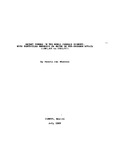Mostrar el registro sencillo del ítem
Recent trends in the world cereals economy, with particular emphasis on maize in Sub-Saharan Africa (1961/65 to 1983/87)
| Autor: | Rheenen, T. Van |
| Año: | 1989 |
| URI: | http://hdl.handle.net/10883/872 |
| Resumen: | During the past 30 years, important changes have occurred in global supply and demand of the world's four major cereals: wheat, rice, maize, and millet/sorghum. Following a prolonged period of high productivity growth, wheat has clearly established itself as the world's topranking cereal in terms of production, utilization, and trade. Maize follows in importance, followed by rice and millet/sorghum. At the global level, overall productivity gains in cereals have been impressive. However, the rate of progress has been uneven across regions and between crops, with the result that it is difficult to predict future growth patterns. Following the Green Revolution, many thought that world hunger had been vanquished forever. The rapid production gains achieved mainly through high-yielding varieties and associated inputs (chiefly fertilizer and water control) were indeed impressive, especially in South Asia, where some of the world's most populated countries went from being chronic food importers to exporters. Recently, however, questions have been raised whether these productivity gains can be sustained. Some of the greatest beneficiaries of the Green Revolution, including China, India, Pakistan, and Mexico, have begun to experience a slow-down in the rate of cereals productivity growth, and recent analysis suggests that historical productivity growth rates may be difficult to sustain (CIMMYT, 1989). Nowhere is the problem of lagging food production more evident than in sub-Saharan Africa. Unlike Asia, where rice and wheat comprise the major food staples, in sub-Saharan Africa human diets are based primarily on coarse grains (millet, sorghum, maize) or on roots and tubers (cassava, yams, sweet potatoes). These latter crops did not benefit directly from the technological innovations associated with the Green Revolution, with the result that food supplies in sub-Saharan Africa were not able to grow as fast as demand. From 1961-1985, population grew at an average annual rate of 2.5% for the region as a whole, while agricultural output grew only 1.5% per year. Thus, per capita food production levels in Africa have actually fallen. Hardly anyone questions the need to revitalize food production in sub-Saharan Africa. However, the best way to achieve this goal is not obvious, particularly in view of the large gap between production possibilities and consumption preferences. Demand for wheat and rice is increasing rapidly in sub-Saharan Africa, yet climatic factors limit the production potential of these two crops throughout large parts of the continent. At the same time, consumption of millet, sorghum, roots, and tubers is declining rapidly, even though these crops are suited to local production conditions. In short, what consumers want cannot be produced, and what can be produced consumers do not want. That leaves maize. At present, the importance of maize varies greatly. In large parts of Eastern and Southern Africa, maize is the principal food staple, produced and consumed by the majority of farm households. By contrast, in most of western and Central Africa, maize is still a relatively minor crop (except for parts of Nigeria, Ghana, Benin, and Cote D'Ivoire). But whatever its present importance, maize clearly has enormous production potential. Even though productivity levels in maize are still low in many countries, improved technologies are already available which have the potential to increase production significantly. This thesis paper, which was designed to contribute to a larger CIMMYT study on maize, attempts to place the recent performance of maize in sub-Saharan Africa in the context of the global cereals economy. The paper presents descriptive analysis of historical production, utilization, and trade patterns in the global cereals economy, and then addresses particular attention to the performance of maize in subSaharan Africa. The paper is organized as follows. Section II reports methodological details and sources of data. Section III presents a description of global trends for wheat, rice, maize, and millet/sorghum. Section IV compares developments in the industrialized countries and the developing countries. Section V takes a closer look at maize in the developing world. Section VI compares the performance of maize to other cereals in sub-Saharan Africa. Section VII presents simple supply and demand projections for maize in sub-Saharan Africa and draws conclusions about likely future developments. |
| Formato: | |
| Lenguaje: | English |
| Editor: | CIMMYT |
| Copyright: | CIMMYT manages Intellectual Assets as International Public Goods. The user is free to download, print, store and share this work. In case you want to translate or create any other derivative work and share or distribute such translation/derivative work, please contact CIMMYT-Knowledge-Center@cgiar.org indicating the work you want to use and the kind of use you intend; CIMMYT will contact you with the suitable license for that purpose. |
| Tipo: | Working Paper |
| Lugar de publicación: | Mexico |
| Páginas: | 63 pages |
| Agrovoc: | CEREALS |
| Agrovoc: | DEVELOPING COUNTRIES |
| Agrovoc: | ECONOMICS |
| Agrovoc: | MAIZE |
| Agrovoc: | CEREALS |
| Agrovoc: | DEVELOPING COUNTRIES |
| Agrovoc: | ECONOMICS |
| Agrovoc: | MAIZE |
Ficheros en el ítem
Este ítem aparece en la(s) siguiente(s) colección(ones)
-
Socioeconomics
Including topics such as farming systems, markets, impact & targeting, innovations, and GIS

